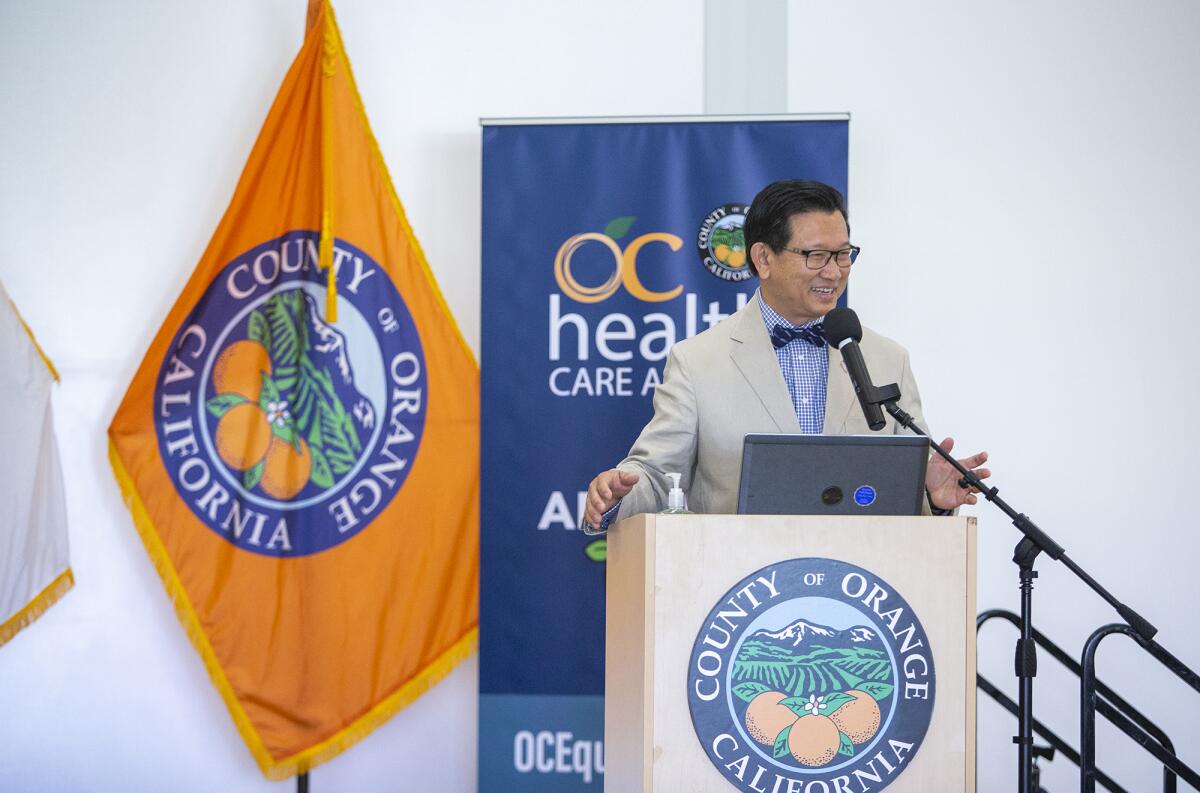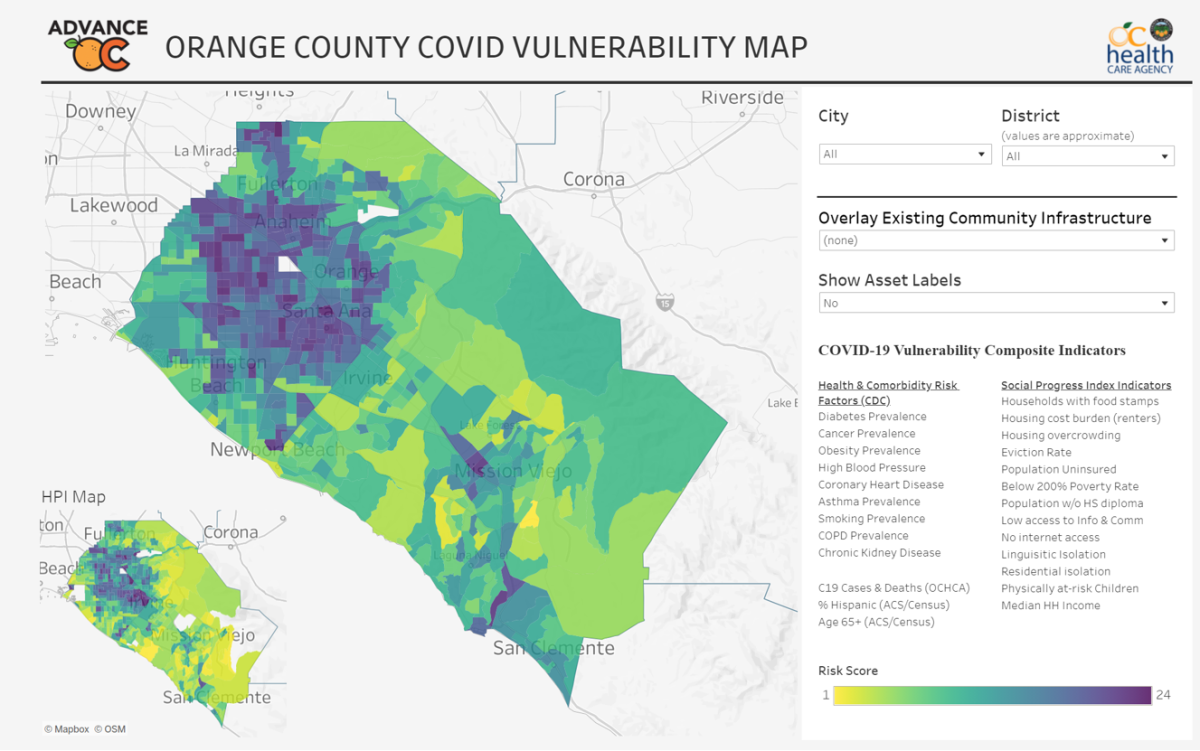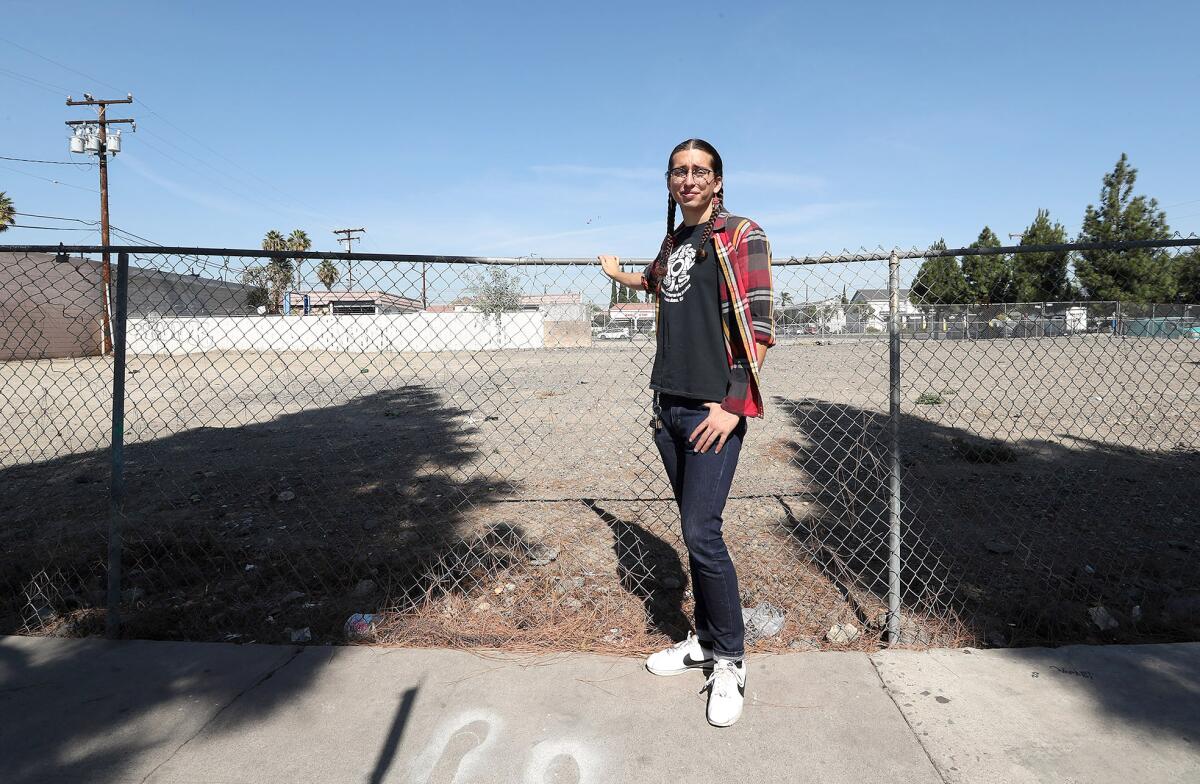Orange County forms task force to solve health equity issues

After the pandemic revealed and, officials say, worsened social and health inequities in the community, Orange County is moving forward with a task force to identify and reduce the longstanding disparities.
The move is part of the county’s Equity in O.C. initiative, which began when the county partnered last year with a local nonprofit to develop a map equity tool that shows which cities and neighborhoods are the most in need.
The Orange County Equity Map could allow the county, cities and nonprofits to better allocate resources to communities that suffer from issues like poor education, hunger, substandard environmental conditions and lack of affordable housing.
Hieu Nguyen, director of the county’s office of population health and equity, said over the phone this week that the equity map will be used by the task force along with other data to help determine which issues to focus on. “The goal for us is really to support in laying the foundation for the Orange County community to address social determinants of health that are impacting health inequities,” Nguyen said. “If we’re able to do all of that, then our vision is really to create a healthier, more resilient and equitable Orange County.”
Nguyen said that a $22.8-million COVID-19 grant from the Centers for Disease Control and Prevention has enabled the county to tackle health equity issues in the community by expanding the county Health Care Agency’s office of population health and equity and organizing the task force, which is made up of local organizations and community members.
Nguyen said the grant has enabled him to add another seven people to the county’s office of population health and equity. Prior to those hires, Nguyen was the only member of the office, which started in December 2020.
“In order to gain the collective impact that we’re seeking, the various entities who are going to address any given social determinant, or any cause of an inequity, needs to be part of the change — so [the Health Care Agency] is itself very committed to that change,” said Karin Kalk, director of project management and quality improvement at the agency. “We’re looking internally at our operational processes, and how we can align with our community and listen to our community voices to make sure that indeed we’re playing our part in addressing systemic inequities. That’s not a small change for a big organization like ours. So we’re working pretty hard to make that move, and at the same time that we’re supporting the community to come together.”
Since early February, the task force has been in the first phase of the initiative, where members have been meeting twice a month to discuss the various equity issues identified in Orange County. Within the next few months, the group will choose three issues to focus on. In addition to using the Orange County Equity Map, the task force is also looking at other data sources, including hearing from the community.
Nguyen said it’s critical to include the voices of the people in the community who have on-the-ground knowledge. Nguyen said that up to 270 people have attended the task force meetings at a time.
“One of the beautiful things, and what we’re very intentional about with this Equity in O.C. initiative, is using a community-informed approach and a data-driven approach,” Nguyen said.

Nguyen said they are aiming to have the three issues chosen by the end of May. In June, the initiative will move to its “action phase,” when community members and organizations looking to make an impact will learn from local and national experts on how to implement strategies to work toward solving the equity issues they chose in the first phase. There will be three “action and learning sessions,” and in between those events there will be coaching and technical assistance support during the 18-month span of the second phase.
In the third phase, Nguyen said that the county will be evaluating and writing up what it learned during the two-year initiative. Even though the initiative is tied to the CDC grant, Nguyen said the county wants to make it a sustainable program.
There are a variety of local organizations in the task force, many of which have worked with the county during the COVID-19 crisis like Latino Health Access, Abrazar and Asian American Senior Citizens Service Center. County agencies including the Social Services Agency and CalOptima have also been present at the meetings. Hospital representatives from the Hospital Assn. of Southern California, Kaiser Permanente and St. Joseph have also been taking part in the task force.
“What’s really significant for us in this work is making sure that the table for the Equity in O.C. task force is inclusive of grassroots organizations and community-based organizations,” Nguyen said. “So there’s organizations that have not historically engaged in county processes who are there, including Viet Rainbow of Orange County, Alianza Translatinx and the United American Indian Involvement, Inc. organization ... So there is a broad base where there’s the traditional community providers, different sectors and different systems, as well as the grassroots level work.”
In addition to taking part in the task force and as part of the equity initiative, the county is offering four grant opportunities for organizations and community members.
These opportunities include funding of up to $1,400 per year for 78 eligible community members, grants of $10,000 per year to 160 organizations, funding of $2.4 million to benefit coalitions that serve minority communities and funding of $180,000 per year to three organizations to provide COVID-19-related services to underserved and underrepresented communities. The fourth grant is primarily meant for groups that serve the American Indian and Alaskan Native community, Native Hawaiian and Pacific Islander community and the Transgender and Gender Nonconforming community.
“We want to make sure that there is equitable participation from the community, including community members as well as community organizations,” Nguyen said. “So we have created opportunities for that.”

Johnice Williams of Peer Voices of OC, an organization that advocates for the behavioral health community, said her group joined the task force earlier this year, and it’s been gratifying to see the county listening to community voices.
She said she believes the task force will have an impact because the county is working with grassroots organizations that have the knowledge and expertise to make lasting change.
“The goal is to have all of the communities throughout Orange County to be represented,” she said over the phone. “So I think everyone now with the Health Care Agency and county are ready to hear what we have to say and ready to implement what it is that we’re discussing.”
Mario Ortega of Abrazar, an organization that helps low-income seniors and families especially in the Latino and Vietnamese communities, said that the county has been showing an unprecedented amount of commitment to achieving health equity since the pandemic worsened and brought to light the health inequities in Orange County. His nonprofit joined the task force after working with the county during the pandemic to help with vaccine equity issues.

Ortega specifically pointed to the various community grants as something he has never seen before at such a “widescale.” He also said the diversity of the groups and community members in the task force is extensive.
“Through the pandemic, it’s shown that there’s so much need out there,” Ortega said. “The pandemic exasperated all the inequities that we know existed. But it’s also brought together a willingness for partners and agencies to work together collaboratively like never before.”
Ortega said there was no way to not address health inequities in the community once the pandemic hit. In Orange County, research showed that there were social and racial disparities during COVID-19 surges. In particular, Latinos were more likely to be diagnosed with the virus and Asian residents were more likely to die of the illness than white residents. State data also showed that the Latino community was not receiving vaccines at a comparable rate to other populations.
“Seeing who was getting sick, who was getting the sickest, who was being hospitalized and who was dying, you could not ignore who it was,” Ortega said. “When you have a pandemic, it’s fuel for all those inequities. So it cannot be ignored. It also took advocacy among the community and nonprofits saying that we have to do something different.”
All the latest on Orange County from Orange County.
Get our free TimesOC newsletter.
You may occasionally receive promotional content from the Daily Pilot.




